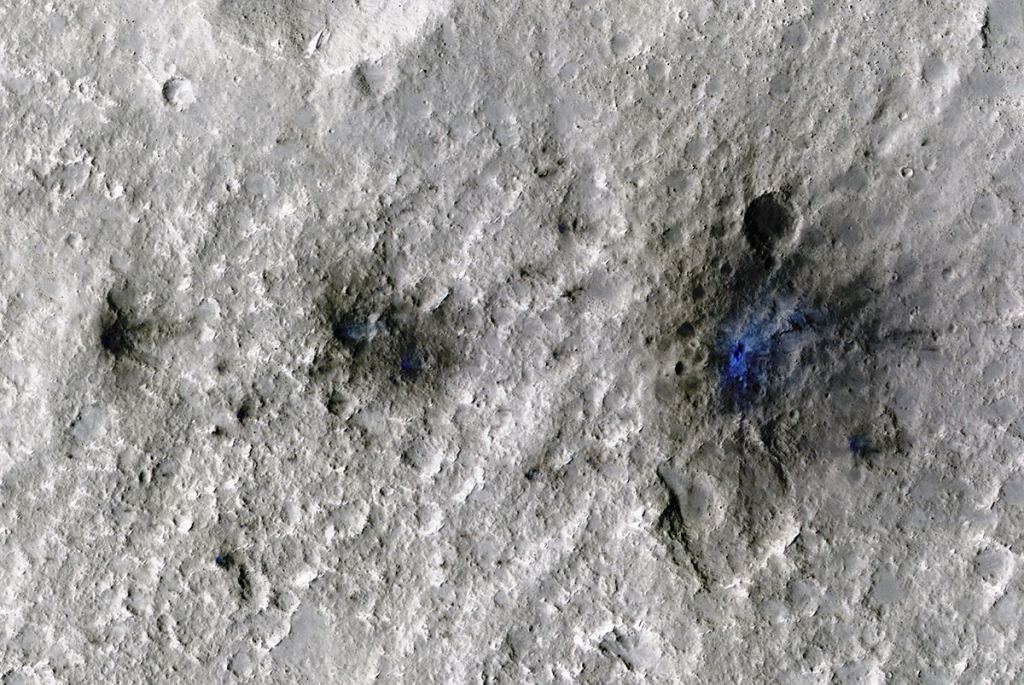For the first time, a spacecraft has detected acoustic and seismic waves from impacts on Mars. NASA’s InSight lander made the detections from four meteoroids that crashed on Mars in 2020 and 2021. Ever since the mission landed on the Red Planet in 2018, scientists have been hoping to be able to detect impacts with InSight’s seismometer, which was mainly designed to sense Marsquakes.
But these impacts are the first the lander has detected. The first of the four confirmed meteoroids – the term used for space rocks before they hit the ground – made the most dramatic splotch. It entered Mars’ atmosphere on Sept.
5, 2021, exploding into at least three shards that each left a crater behind. For confirmation, InSight’s scientists worked with the team from NASA’s Mars Reconnaissance Orbiter, which was scheduled to fly over the estimated impact site, and bingo, it found the impacts. The orbiter used its black-and-white Context Camera to reveal three darkened spots on the surface.
After locating these spots, the orbiter’s team used the High-Resolution Imaging Science Experiment camera, or HiRISE, to get a color close-up of the craters. Scientists say the meteoroid could have left additional craters in the surface, but they would be too small to see in HiRISE’s images. “After three years of InSight waiting to detect an impact, those craters looked beautiful,” said Ingrid Daubar of Brown University, a co-author of a paper detailing the findings, published in Nature Geoscience.
InSight’s seismic data, in combination with orbital images, can be used to rebuild a meteoroid’s trajectory and the size of its shock wave. Every meteoroid creates a shock wave as it hits the atmosphere and an explosion as it hits the ground. These events send sound waves through the atmosphere.
The bigger the explosion, the more this sound wave tilts the ground when it reaches InSight. The lander’s seismometer is sensitive enough to measure how much the ground tilts from such an event and in what direction. “We’re learning more about the impact process itself,” Garcia said.
“We can match different sizes of craters to specific seismic and acoustic waves now. ” InSight recorded the sound one of the impacts made, and you can listen to it here: Scientists said the four meteoroid impacts confirmed so far produced small quakes with a magnitude of no more than 2. 0.
Those smaller quakes provide scientists with only a glimpse into the Martian crust, while seismic signals from larger quakes, like the magnitude 5 event that occurred in May 2022, can also reveal details about the planet’s mantle and core. This collage shows three other meteoroid impacts that were detected by the seismometer on NASA’s InSight lander and captured by the agency’s Mars Reconnaissance Orbiter using its HiRISE camera. Credits: NASA/JPL-Caltech/University of Arizona.
Knowing about the rate of impacts is important because that helps planetary scientists estimate the age of a planet’s surface. “Impacts are the clocks of the solar system,” said the paper’s lead author, Raphael Garcia of Institut Supérieur de l’Aéronautique et de l’Espace in Toulouse, France. “We need to know the impact rate today to estimate the age of different surfaces,” adding that the impacts detected will be critical to refining Mars’ timeline.
InSight captured this image of one of its dust-covered solar panels on April 24, 2022, the 1,211th Martian day, or sol, of the mission. Credits: NASA/JPL-Caltech However, the science team have been puzzled why they haven’t detected more meteoroid impacts on Mars, which is next to the solar system’s main asteroid belt, which provides an ample supply of space rocks to scar the planet’s surface. Because Mars’ atmosphere is just 1% as thick as Earth’s, more meteoroids pass through it without disintegrating.
But there won’t be much more time for InSight to detect more impacts. Martian dust is covering the lander’s solar panels, reducing the amount of available power. The InSight team announced is May that the spacecraft will eventually shut down, although they were uncertain when.
As of now, engineers are predicting, based on the latest power readings, that the lander could shut down between October of this year and January 2023. During its mission, InSight has detected over 1,300 Marsquakes. Further Reading:Nature Geoscience paperBrown University press releaseNASA press release The post InSite Heard Four Meteoroids Crash Into Mars appeared first on Universe Today.
.
From: universetoday
URL: https://www.universetoday.com/157686/insite-heard-four-meteoroids-crash-into-mars/



